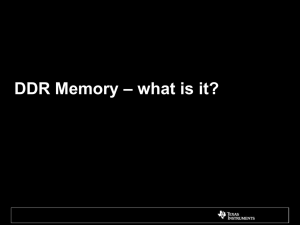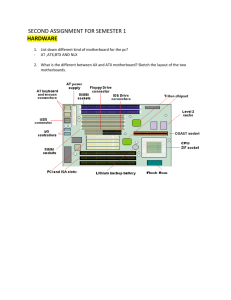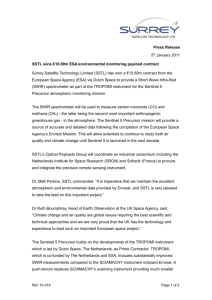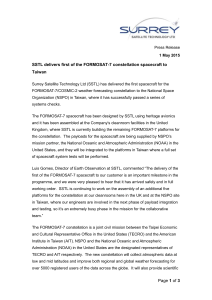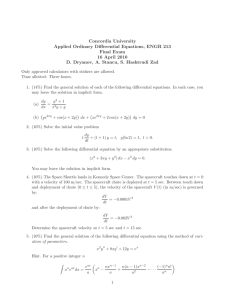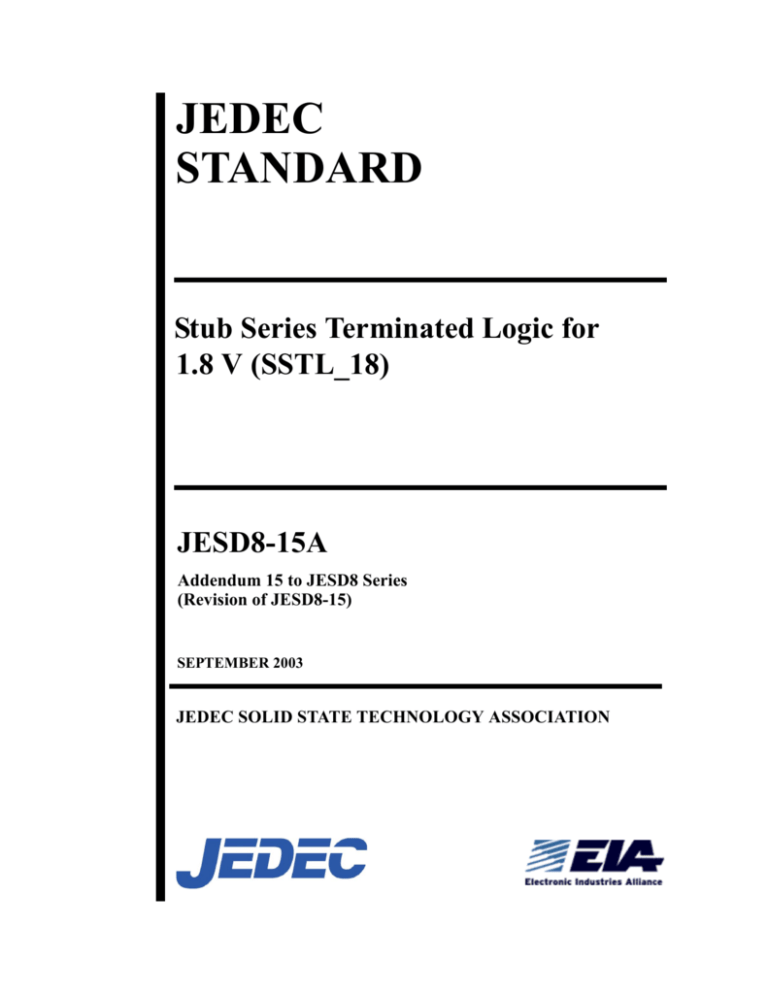
JEDEC
STANDARD
Stub Series Terminated Logic for
1.8 V (SSTL_18)
JESD8-15A
Addendum 15 to JESD8 Series
(Revision of JESD8-15)
SEPTEMBER 2003
JEDEC SOLID STATE TECHNOLOGY ASSOCIATION
NOTICE
JEDEC standards and publications contain material that has been prepared, reviewed, and approved
through the JEDEC Council level and subsequently reviewed and approved by the EIA General
Counsel.
JEDEC standards and publications are designed to serve the public interest through eliminating
misunderstandings between manufacturers and purchasers, facilitating interchangeability and
improvement of products, and assisting the purchaser in selecting and obtaining with minimum delay
the proper product for use by those other than JEDEC members, whether the standard is to be used
either domestically or internationally.
JEDEC standards and publications are adopted without regard to whether or not their adoption may
involve patents or articles, materials, or processes. By such action JEDEC does not assume any
liability to any patent owner, nor does it assume any obligation whatever to parties adopting the
JEDEC standards or publications.
The information included in JEDEC standards and publications represents a sound approach to
product specification and application, principally from the solid state device manufacturer viewpoint.
No claims to be in conformance with this standard may be made unless all requirements stated in the
standard are met.
Inquiries, comments, and suggestions relative to the content of this JEDEC standard or publication
should be addressed to JEDEC Solid State Technology Association, 2500 Wilson Boulevard,
Arlington, VA 22201-3834, (703)907-7559 or www.jedec.org.
Published by
©JEDEC Solid State Technology Association 2003
2500 Wilson Boulevard
Arlington, VA 22201-3834
This document may be downloaded free of charge, however JEDEC retains the copyright on this material.
By downloading this file the individual agrees not to charge for or resell the resulting material.
Price: Please refer to the current
Catalog of JEDEC Engineering Standards and Publications or call Global Engineering
Documents, USA and Canada (1-800-854-7179), International (303-397-7956)
Printed in the U.S.A.
All rights reserved
P LE A S E !
D O N ’T V IO LA T E
THE
LA W !
T h is d o cu m ent is co pyrighted by the JE D E C S olid S tate T echn ology A sso ciatio n
and m ay n o t b e reprod u ced w itho u t p erm issio n.
O rgan iz atio ns m ay ob tain perm issio n to rep rod uce a lim ited n um b er o f co pies
thro ugh enterin g in to a licen se agreem en t. F or info rm ation , con tact:
JE D E C S o lid S tate T ech no lo gy A sso ciatio n
2 50 0 W ilson B ou levard
A rlin gton , V irginia 2 22 0 1-38 3 4
o r call (7 0 3) 9 07 -75 5 9
JEDEC Standard No. 8-15A
Page 1
STUB SERIES TERMINATED LOGIC FOR 1.8 V (SSTL_18)
(From JEDEC Board Ballots JCB-02-36, JCB-02-37, JCB-02-55, JCB-02-56, JCB-02-57, JCB-02-83,
JCB-02-119, and JCB-03-40 formulated under the cognizance of the JC-16 Committee on Interface
Technology.)
1 Scope
This standard defines the input, output specifications and ac test conditions for devices that are
designed to operate in the SSTL_18 logic switching range, nominally 0 V to 1.8 V. The standard may
be applied to ICs operating with separate VDD and VDDQ supply voltages. The VDD value is not
specified in this standard; however VDD and VDDQ will have the same voltage level in many cases.
1.1 Standard Structure
The standard is defined in four clauses:
The first clause defines pertinent supply voltage requirements common to all compliant ICs.
The second clause defines the minimum dc and ac input parametric requirements and ac test
conditions for inputs on compliant devices.
The third clause specifies the minimum required output characteristics of, and ac test conditions for,
compliant outputs targeted for various application environments.
The fourth clause specifies requirements for differential signaling.
The full input reference level (VREF) range specified is required on each IC in order to allow any
SSTL_18 integrated circuit to receive signals from any SSTL_18 output driver.
1.2 Rationale and assumptions
The SSTL_18 standard has been developed particularly with the objective of providing a relatively
simple upgrade path from MOS push-pull interface designs. The standard is particularly intended to
improve operation in situations where busses must be isolated from relatively large stubs. External
resistors provide this isolation and also reduce the on-chip power dissipation of the drivers. Busses
may be terminated by resistors to an external termination voltage.
Actual selection of the resistor values is a system design decision and beyond the scope of this
standard. However in order to provide a basis, the driver characteristics will be derived in terms of a
typical 50 Ω environment.
While driver characteristics are derived from a 50 Ω environment, this standard will work for other
impedance levels. The system designer will be able to vary impedance levels, termination resistors
and supply voltage and be able to calculate the effect on system voltage margins. This is
accomplished precisely because drivers and receivers are specified independently of each other.
The standard defines a reference voltage VREF which is used at the receivers as well as a voltage
VTT to which termination resistors are connected. In typical applications, VREF and VTT are nominally
equal to VDDQ/2.
JEDEC Standard No. 8-15A
Page 2
2 Supply voltage and input logic levels
The standard defines both the ac and dc input signal values. Making this distinction is important
for the design of the high gain, differential receivers that are required. The ac values indicate the
voltage levels at which the receiver must meet its timing specifications. The dc values indicate
the voltage levels at which the final logic state of the receiver is unambiguously defined. Once the
receiver input has crossed the ac value, the receiver will change to the new logic state. The new
logic state will then be maintained as long as the input stays beyond the dc threshold. This
approach is intended to provide predictable receiver timing in the presence of input waveform
“ringing”. The relationship of the different levels is shown in Figure 1. An example of ringing is
illustrated in the waveform.
VDDQ
VIH(ac)
VIH(dc)
VREF
VIL(dc)
VIL(ac)
VSS
Figure 1 — SSTL_18 Input Voltage Levels
2.1 Supply Voltage Levels
Table 1 — Supply Voltage Levels
Symbol
Parameter
Min.
Nom.
Max.
Units
Notes
VDDQ
Output supply voltage
1.7
1.8
1.9
V
VREF
Input reference voltage
833
900
969
mV
1, 2
VTT
Termination voltage
VREF - 40
VREF
VREF + 40
mV
3
NOTE 1 The value of VREF may be selected by the user to provide optimum noise margin in the system.
Typically the value of VREF is expected to be (50 +/- 1)% * VDDQ of the transmitting device, e.g., VREF min
= 0.49 * VDDQ min and VREF max = 0.51 * VDDQ max. VREF is expected to track variations in VDDQ.
NOTE 2 Peak to peak ac noise on VREF may not exceed +/- 2% of VREF(dc).
NOTE 3 VTT is expected to track VREF of the receiving device.
JEDEC Standard No. 8-15A
Page 3
2.2 Input logic levels
Table 2 — DC input logic levels
Symbol
Parameter
Min.
Max.
Units
Notes
VIH(dc)
dc input logic high
VREF + 125
VDDQ + 300
mV
1
VIL(dc)
dc input logic low
-300
VREF - 125
mV
1
NOTE 1 Within this standard, it is the relationship of the VDDQ of the driving device and the VREF of the
receiving device that determines noise margins. However, in the case of VIH(dc) max (i.e., input overdrive), it is
the VDDQ of the receiving device that is referenced. In the case where a device is implemented that supports
SSTL_18 inputs but has no SSTL_18 outputs (e.g., a translator), and therefore no VDDQ supply voltage
connection, inputs must tolerate input overdrive to 2.2 V (VDDQ max + 300 mV).
Table 3 — AC input logic levels
Symbol
Parameter
Min.
Max.
Units
VIH(ac)
ac input logic high
VREF + 250
-
mV
VIL(ac)
ac input logic low
-
VREF - 250
mV
Notes
2.3 AC test conditions
The ac input test conditions are specified to be able to obtain reliable, reproducible test results in an
automated test environment, where a relatively high noise environment makes it difficult to create
clean signals with limited swing. The tester may therefore supply signals with a 1.0 V peak to peak
swing to drive the receiving device. Note however, that all timing specifications are still set relative to
the ac input level. This is illustrated in Figure 2.
Table 4 — AC input test conditions
Symbol
Condition
Value
Units
Notes
0.5 * VDDQ
V
1, 4
VREF
Input reference voltage
VSWING(MAX)
Input signal maximum peak to peak swing
1.0
V
1, 2
SLEW
Input signal minimum slew rate
1.0
V/ns
3
NOTE 1 Input waveform timing is referenced to the input signal crossing through the VREF level applied to the
device under test. Table 1 identifies the VREF range supported in SSTL_18.
NOTE 2 Compliant devices must still meet the VIH(ac) and VIL(ac) specifications under actual use conditions.
NOTE 3 The input signal minimum slew rate is to be maintained over the range from VIL(dc) max to VIH(ac) min
for rising edges and the range from VIH(dc) min to VIL(ac) max for falling edges as shown in Figure 2, consistent
with the specifications of Tables 2 and 3. This is not a monotonicity requirement: ringing is still allowed as
shown in Figure 1.
NOTE 4 ac test conditions may be measured under nominal voltage conditions as long as the supplier can
demonstrate by analysis that the device will meet its timing specifications under all supported voltage
conditions.
JEDEC Standard No. 8-15A
Page 4
2.3 AC test conditions (cont’d)
Start of Falling Edge Input Timing Start of Rising Edge Input Timing
VSWING(MAX)
delta TF
Falling Slew =
VREF
VIL(dc) max
VIL(ac) max
VSS
delta TR
VIH(dc) min - VIL(ac) max
Rising Slew =
delta TF
VDDQ
VIH(ac) min
VIH(dc) min
VIH(ac) min - VIL(dc) max
delta TR
Figure 2 — AC Input Test Signal Waveform
3 SSTL_18 Output Buffers
3.1 Overview
This specification sets minimum requirements for output buffers such that when they are applied
within the range of power supply voltages specified in SSTL_18 and are used in conjunction with
SSTL_18 input receivers, then the input receiver specifications can be met or exceeded. The
specifications are quite different from traditional specifications, where minimum values for VOH
and maximum values for VOL are set that apply to the entire supply range. In SSTL_18, the input
voltage provided to the receiver depends on the driver as well as on the termination voltage and
termination resistors. Figure 3 shows the typical dc environment that is presented to the output
buffer.
VDDQ
VTT
RT
25 Ω
Receiver
RS
Output
Buffer
(Driver)
20 Ω
VOUT
VREF
VIN
VSS
Figure 3 — Typical output buffer (driver) environment
In this environment, MOS output devices are deep into their triode region, so SSTL_18 driver
characteristics are specified to ensure a driver output resistance (RON) no greater than 21 Ω at
the minimum VDDQ. It is understood that MOS devices are not perfectly linear, but designers are
expected to scale up as needed to ensure that they meet the required operating points.
JEDEC Standard No. 8-15A
Page 5
3.2 SSTL_18 output buffers
3.2.1 Push-pull output buffer for symmetrically double parallel terminated loads with series
resistor (VTT = 0.5 * VDDQ)
Table 5 — Output dc current drive
Symbol
Parameter
Min.
Max.
Units
Notes
IOH(dc)
Output minimum source dc current
-13.4
-
mA
1, 3, 4
IOL(dc)
Output minimum sink dc current
13.4
-
mA
2, 3, 4
NOTE 1 VDDQ = 1.7 V; VOUT = 1420 mV. (VOUT - VDDQ)/IOH must be less than 21 Ω for values of VOUT
between VDDQ and VDDQ - 280 mV.
NOTE 2 VDDQ = 1.7 V; VOUT = 280 mV. VOUT/IOL must be less than 21 Ω for values of VOUT between 0 V and
280 mV.
NOTE 3 The dc value of VREF applied to the receiving device is set to VTT
NOTE 4 The values of IOH(dc) and IOL(dc) are based on the conditions given in Notes 1 and 2. They are used
to test device drive current capability to ensure VIH min plus a noise margin and VIL max minus a noise margin
are delivered to an SSTL_18 receiver. The actual current values are derived by shifting the desired driver
operating point (see Section 3.3) along a 21 Ω load line to define a convenient driver current for measurement.
3.2.2 SSTL_18 output ac test conditions
This testing regimen is used to verify SSTL_18 output buffers (push-pull output buffers designed for
symmetrically double parallel terminated loads with series resistor).
This clause is added to set the conditions under which the driver ac specifications can be tested. The
test circuit is assumed to be similar to the circuit shown in Figure 4. The ac test conditions may be
measured under nominal voltage conditions as long as the supplier can demonstrate by analysis,
that the device will meet its timing specifications under all supported voltage conditions. Table 6
assumes that ± 335 mV must be developed across the effectively 25 Ω termination resistor at VIN
(13.4 mA * 25 Ω = 335 mV). With a series resistor of 20 Ω this translates into a minimum requirement
of 603 mV swing relative to VTT, at the output of the device
(13.4 mA * 45 Ω = 603 mV).
JEDEC Standard No. 8-15A
Page 6
3.2 SSTL_18 output buffers (cont’d)
3.2.2 SSTL_18 output ac test conditions (cont’d)
VTT = 0.5 * VDDQ
Device
under
test
VOUT
VDDQ
VREF = 0.5 * VDDQ
RS = 20 Ω
RT2 = 50 Ω
Z0 = 50 Ω
RT1 = 50 Ω
VSS
VREF = 0.5 * VDDQ
VTT = 0.5 * VDDQ
Figure 4 — Example of SSTL_18 symmetrically double parallel terminated output load
with series resistor
Table 6 — AC Test Conditions
Symbol
Condition
Value
Units
VOH
Min. required output pull-up under ac test load
VTT + 603
mV
VOL
Max. required output pull-down under ac test load
VTT - 603
mV
VOTR
Output timing measurement reference level
0.5 * VDDQ
mV
Notes
1
NOTE 1 The VDDQ of the device under test is referenced.
3.3 SSTL_18 noise margin
SSTL_18 output devices are characterized for a linear 21 Ω maximum output resistance (RON).
The noise margin at the receiver under worst-case conditions is thus calculated as follows:
Assume RS = 20 Ω and RT = 25 Ω.
VDDQ min = 1.7 V
VREF min = 0.49 * VDDQ min = 833 mV
VTT = VREF min + 40 mV = 873 mV
VIN = VTT * (RON + RS)/(RON + RS + RT) = 873 mV * 41 Ω / 66 Ω = 542 mV
VREF - VIN = 833 mV - 542 mV = 291 mV
VIN(ac) min = 250 mV (from Table 3).
JEDEC Standard No. 8-15A
Page 7
3.3 SSTL_18 noise margin (cont’d)
As described, the receiver sees an input of 291 mV and only requires VIN(ac) min = 250 mV, for a
gross margin of 41 mV. System designers may allocate this margin as judgment dictates. An
SSTL_18 driver meeting these conditions while driving low would have the operating point:
IOUT = IOL = (VTT - VIN)/RT = (873 mV - 542 mV) / 25 Ω = 13.24 mA
VOUT = VOL = VIN - IOUT * RS = 542 mV - 13.24 mA * 20 Ω = 277.2 mV
A similar calculation may be done for the case where the receiver is driven high. In either case, the
resulting values are shifted along a 21 Ω load line to establish the output dc current drive
requirements given in Table 5.
4 Other applications (For reference only)
The specifications for SSTL_18 are based on an environment comprising both series and parallel
terminating resistors. In this non-binding section, some derived applications are shown. Clearly it is
not the intention to show all possible variations in this standard.
4.1 Push-pull output buffer for source series and single parallel terminated loads, single
destination
Applications exist where a signal source may reside at some distance from a single load. In this
case, it may be advantageous to series terminate the signal source and parallel terminate at the
load. An example of this situation is shown in Figure 5.
VTT = 0.5 * VDDQ
Device
under
test
VOUT
VDDQ
VREF = 0.5 * VDDQ
RS = 20 Ω
RT = 25 Ω
Z0 = 50 Ω
VREF = 0.5 * VDDQ
Figure 5 — Example of SSTL_18 symmetrically single parallel terminated output load with
series resistor, single or lumped load shown
4.2 Push-pull output buffer for source series and single parallel terminated loads, multi-drop
bus
Particularly in memory systems, a signal source may reside at some distance from several relatively
closely spaced loads. In this case, it may be advantageous to series terminate the signal source and
parallel terminate at or beyond the load farthest from the source. An example of this situation for two
loads is shown in Figure 6.
JEDEC Standard No. 8-15A
Page 8
4.2 Push-pull output buffer for source series and single parallel terminated loads, multidrop bus (cont’d)
Device
under
test
VTT = 0.5 * VDDQ
VDDQ
VREF
VOUT
RS = 20 Ω
RT = 25 Ω
Z0 = 50 Ω
Z0 = 50 Ω
RS = 20 Ω
RS = 20 Ω
VREF
VREF
VREF = 0.5 * VDDQ
Figure 6 — Example of SSTL_18 symmetrically single parallel terminated output load with
series resistor, multi-drop bus
4.3 Push-pull output buffer for source series terminated loads
In some applications the system designer may wish to terminate at the signal source rather than
at the end of the transmission line. One advantage of this approach is that there is no need for a
VTT power supply. An example is shown in Figure 7. A larger value of RS than that shown in the
Figure may be chosen in order to provide a better termination of the reflected wave.
Device
under
test
VOUT
VDDQ
VREF = 0.5 * VDDQ
RS = 20 Ω
Z0 = 50 Ω
VREF = 0.5 * VDDQ
Figure 7 — Example of SSTL_18 source series terminated load
JEDEC Standard No. 8-15A
Page 9
4.4 Push-pull output buffer for symmetrically single parallel terminated loads
Sometimes the system application requires longer transmission lines that will only be terminated at
one end. An example of this may be address drivers on a memory board. An example is shown in
Figure 8.
VTT = 0.5 * VDDQ
Device
under
test
VDDQ
VREF = 0.5 * VDDQ
VOUT
RT = 50 Ω
Z0 = 50 Ω
VREF = 0.5 * VDDQ
Figure 8 — Example of SSTL_18 symmetrically single parallel terminated load
4.5 Push-pull output buffer for symmetrically double parallel terminated loads
Finally, the system designer may require a bus system which must be terminated at both sides.
However, the drivers are connected directly onto the bus so there are no stubs present. In that case,
the designer may decide to eliminate the series resistors entirely as shown in Figure 9.
VTT = 0.5 * VDDQ
Device
under
test
VDDQ
VREF = 0.5 * VDDQ
VOUT
RT2 = 50 Ω
Z0 = 50 Ω
RT1 = 50 Ω
VREF = 0.5 * VDDQ
VTT = 0.5 * VDDQ
Figure 9 — Example of SSTL_18 symmetrically double parallel terminated load
JEDEC Standard No. 8-15A
Page 10
4.6 Reference load for timing measurements
The reference load for timing measurement of SSTL_18 output drivers is shown in Figure 10.
Device
under
test
VDDQ
RT = 25 Ω
VTT = 0.5 * VDDQ (= 0.9 V typical)
Figure 10 — Reference load for timing measurements
5 Differential signals
5.1 Overview
The following specifications describe differential signalling in SSTL_18 based systems. This is
particularly relevant to DDRII DRAM clocks and data strobes, but the specification is intended to
address any usage of SSTL_18 differential signals.
5.2 Differential input parameters
Table 7 — Differential dc input logic levels
Symbol
Parameter
Min.
Max.
Units
Notes
VIN(dc)
dc input signal voltage
-0.3
VDDQ + 0.3
V
1
VID(dc)
dc differential input voltage
0.25
VDDQ + 0.6
V
2
NOTE 1 VIN(dc) specifies the allowable dc excursion of each differential input.
NOTE 2 VID(dc) specifies the input differential voltage |VTR-VCP| required for switching, where VTR is the
“true” input level and VCP is the “complementary” input level. The minimum value is equal to VIH(dc) - VIL(dc)
from Table 2.
JEDEC Standard No. 8-15A
Page 11
5.2 Differential input parameters (cont’d)
Table 8 — Differential ac input logic levels
Symbol
Parameter
VID(ac)
ac differential input voltage
VIX(ac)
ac differential cross point
voltage
Min.
Max.
Units
Notes
0.5
VDDQ + 0.6
V
1
0.5 * VDDQ
- 0.175
0.5 * VDDQ
+ 0.175
V
2
NOTE 1 VID(ac) specifies the input differential voltage |VTR-VCP| required for switching, where VTR is the “true”
input signal and VCP is the “complementary” input signal. The minimum value is equal to VIH(ac) - VIL(ac) from
Table 3.
NOTE 2 The typical value of VIX(ac) is expected to be about 0.5 * VDDQ of the transmitting device and VIX(ac)
is expected to track variations in VDDQ. VIX(ac) indicates the voltage at which differential input signals must
cross. See Figure 11.
VDDQ
VTR
VID
Crossing Point
VIX or VOX
VCP
VSS
Figure 11 — SSTL_18 differential signal levels
JEDEC Standard No. 8-15A
Page 12
5.3 AC test conditions
The differential ac test conditions are specified to be able to obtain reliable, reproducible test
results in an automated test environment, where a relatively high noise environment makes it
difficult to create clean signals with limited swing. The tester may therefore supply signals with a
1.0 V peak-to-peak swing to drive the receiving device. Note however, that all timing
specifications are still set relative to the differential ac input level. This is illustrated in Figure 12.
Table 9 — Differential AC Input Test Conditions
Symbol
Parameter
Vr
Input timing measurement reference level
VSWING
Input signal peak to peak swing voltage
SLEW
Input signal slew rate
Min.
Max.
VIX (cross point)
Units
Notes
V
1
-
1.0
V
2
1.0
-
V/ns
3
NOTE 1 In all cases, input waveform timing is referenced to the crossing point level (VIX) of two input
signals (VTR and VCP) applied to the device under test, where VTR is the “true” input signal and VCP is the
“complementary” input signal. Table 8 identifies the VIX(ac) range supported for SSTL_18 differential inputs.
NOTE 2 A 1.0 V input pulse level is specified to allow consistent, repeatable test results in an automatic
test equipment (ATE) environment. Compliant devices must meet the VID(ac) specification under actual use
conditions. See Table 8.
NOTE 3 The input signal minimum slew rate is to be maintained over the range from VIL(dc) max to VIH(ac)
min for rising edges and the range from VIH(dc) min to VIL(ac) max for falling edges, consistent with Figure 2
and Tables 2 and 3 of this specification.
VDDQ
VTR
VSWING
VCP
VSS
Figure 12 — Differential ac input test signal wave form
JEDEC Standard No. 8-15A
Page 13
5.4 Differential output parameters
Differential outputs may be created using either true differential drivers or by combining pairs of
SSTL_18 compliant, single-ended drivers driven from true and complementary signals. As a result,
differential output parameters are assumed to be identical to those for single-ended outputs as given
in Section 3, except where additional specifications are provided in Table 10.
Table 10 — Differential AC Output Parameters
Symbol
Parameter
VOX(ac)
ac differential cross point
voltage
Min.
Max.
Units
Notes
0.5 * VDDQ
- 0.125
0.5 * VDDQ
+ 0.125
V
1
NOTE 1 The typical value of VOX(ac) is expected to be about 0.5 * VDDQ of the transmitting device and VOX(ac)
is expected to track variations in VDDQ. VOX(ac) indicates the voltage at which differential output signals must
cross. See Figure 11.
5.5 Example of SSTL_18 differential signals (Reference Only)
For reference only, Figure 13 shows differential inputs independently terminated with 25 Ω resistors.
The values of IOH(dc) and IOL(dc) must satisfy Table 5.
VTT = 0.5 * VDDQ
VDD
VDD
VREF
0.5 * VDDQ
VOUT
RT = 25 Ω
50 Ω
RS = 20 Ω
50 Ω
VOUT
RS = 20 Ω
DUT
Receiver
Figure 13 — Example of SSTL_18 differential signalling using series resistors and
independent parallel termination resistors.
JEDEC Standard No. 8-15A
Page 14
5.6 Example of SSTL_18 differential clock signals (Reference Only)
For reference only, Figure 14 shows a differential clock with a 100 Ω differential termination
resistor. The values of IOH(dc) and IOL(dc) must satisfy Table 5.
VDD
VDD
VREF
0.5 * VDDQ
VOUT
RT = 100 Ω
50 Ω
RS =20 Ω
50 Ω
VOUT
RS =20 Ω
Receiver
DUT
Figure 14 — Example of SSTL_18 differential signalling using series resistors and a
differential termination resistor.
Table 11 — VISO Specifications (Reference Only)
Symbol
Parameter
VISO
Input signal offset voltage
∆VISO
Differential common mode stability
Min.
Max.
0.5 * VDDQ
-
+200
Units
Notes
V
1
mV
2
NOTE 1 The value of VISO is expected to be (|VTR+VCP|)/2 in case of each differential pair directly
terminated by a 100 Ω resistor, where VTR is the “true” input signal voltage and VCP is the
“complementary” input signal voltage, respectively. See Figure 15.
NOTE 2 ∆VISO is the allowed variation in the input signal offset voltage, VISO. See Figure 15.
JEDEC Standard No. 8-15A
Page 15
5.6 Example of SSTL_18 differential clock signals (Reference Only) (cont’d)
VTR
VCP
GND
|VID|
0 V Diff
∆VISO
VISO
GND
VISO
Figure 15 — Input signal offset voltage (Reference Only)
JEDEC Standard No. 8-15A
Page 16
6 Annex A (informative) Differences between JESD8-15A and JESD8-15
This table breifly describes most of the changes made to entries that appear in this standard,
JESD8-15A, compared to its predecessor, JESD8-15 (October 2002). If the change to a concept
involves any words added or deleted, it is included. Punctuation changes may not be included.
Location
Description of Change
Page 2, 1st paragraph, 5th sentence
deleted ‘for a sufficient period (see ts below)’
Page 2, Figure 1
Deleted all references to ts
Page 2
Deleted paragraph of text below Figure 1
Page 10
Added subclause 4.6
Page 10
Added Figure 10
Page 11 - 15
Original referencs to Figures 10 - 14 in subclause 5.2
through 5.6 were modified (incremented) to account
for the addition of Figure 10.
Standard Improvement Form
JEDEC JESD8-15A
The purpose of this form is to provide the Technical Committees of JEDEC with input from the industry regarding
usage of the subject standard. Individuals or companies are invited to submit comments to JEDEC. All comments
will be collected and dispersed to the appropriate committee(s).
If you can provide input, please complete this form and return to:
JEDEC
Attn: Publications Department
2500 Wilson Blvd. Suite 220
Arlington, VA 22201-3834
Fax: 703.907.7583
1.
I recommend changes to the following:
Requirement, clause number
Test method number
Clause number
The referenced clause number has proven to be:
Unclear
Too Rigid
In Error
Other
2.
Recommendations for correction:
3.
Other suggestions for document improvement:
Submitted by
Name:
Phone:
Company:
E-mail:
Address:
City/State/Zip:
Date:

